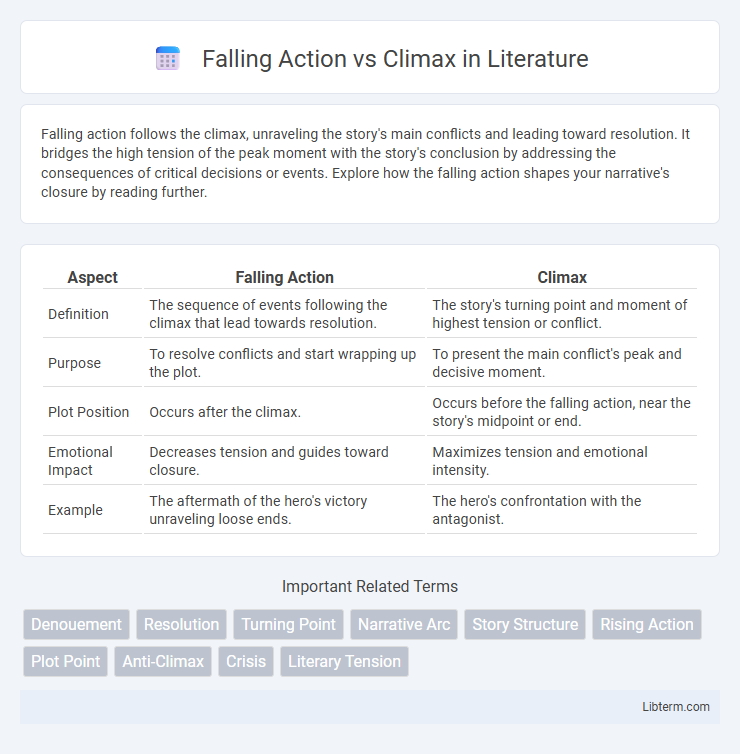Falling action follows the climax, unraveling the story's main conflicts and leading toward resolution. It bridges the high tension of the peak moment with the story's conclusion by addressing the consequences of critical decisions or events. Explore how the falling action shapes your narrative's closure by reading further.
Table of Comparison
| Aspect | Falling Action | Climax |
|---|---|---|
| Definition | The sequence of events following the climax that lead towards resolution. | The story's turning point and moment of highest tension or conflict. |
| Purpose | To resolve conflicts and start wrapping up the plot. | To present the main conflict's peak and decisive moment. |
| Plot Position | Occurs after the climax. | Occurs before the falling action, near the story's midpoint or end. |
| Emotional Impact | Decreases tension and guides toward closure. | Maximizes tension and emotional intensity. |
| Example | The aftermath of the hero's victory unraveling loose ends. | The hero's confrontation with the antagonist. |
Understanding the Structure: Climax vs Falling Action
The climax represents the story's peak moment of tension and conflict resolution, where the protagonist faces their greatest challenge. Falling action follows the climax, depicting the events that occur as the story's tension decreases and consequences unfold. Understanding the distinction between climax and falling action is crucial to analyzing narrative structure and pacing in literature and film.
Definition of Climax in Storytelling
The climax in storytelling is the turning point where the main conflict reaches its highest intensity, resulting in a decisive confrontation or revelation. It serves as the moment of greatest emotional impact and narrative tension, fundamentally changing the direction of the story. Falling action follows the climax, resolving conflicts and leading toward the story's conclusion.
Defining the Falling Action in Narrative
The falling action in a narrative follows the climax and reveals the consequences of the story's turning point, guiding the plot toward resolution. It helps to resolve conflicts, decrease tension, and answer remaining questions posed during the climax. This phase bridges the peak emotional moment with the story's conclusion, ensuring a coherent and satisfying narrative structure.
Key Differences Between Climax and Falling Action
The climax represents the story's turning point with the highest tension and decisive moment for the protagonist, while falling action follows as events start to resolve conflicts and consequences unfold. Climax delivers peak emotional intensity and critical decisions, whereas falling action decreases tension and prepares the narrative for closure. Understanding these phases highlights how climax drives main conflict resolution and falling action guides the story toward its conclusion.
The Role of Climax in Plot Development
The climax serves as the pivotal turning point in plot development, marking the moment of highest tension and conflict resolution potential. It drives character decisions and propels the story toward resolution by intensifying stakes and emotional impact. Falling action follows by unraveling consequences and guiding the narrative toward closure.
How Falling Action Shapes Story Resolution
Falling action directly follows the climax, guiding characters and plotlines toward resolution by addressing conflicts introduced earlier. This phase diminishes tension and clarifies consequences, setting the stage for a satisfying conclusion. Effective falling action ensures all loose ends are tied, reinforcing the story's thematic message and emotional impact.
Common Misconceptions About Climax and Falling Action
The climax is often mistaken as the story's ending, but it is actually the turning point where the main conflict reaches its peak intensity, setting up the consequences that follow. Falling action is commonly misunderstood as an unimportant wrap-up, yet it crucially resolves subplots and guides the narrative toward closure after the climax. Both elements serve distinct roles: the climax drives the emotional and narrative intensity, while the falling action manages the fallout and leads into the resolution.
Examples of Climax and Falling Action in Literature
The climax in literature represents the story's most intense and pivotal moment, such as the confrontation between Harry Potter and Voldemort in J.K. Rowling's "Harry Potter and the Deathly Hallows." Falling action follows the climax, illustrating the consequences and easing tension, like the resolution after the Battle of Hogwarts, where characters begin to rebuild their lives. These elements structure narratives by heightening conflict at the climax and providing closure during falling action.
Tips for Writing Effective Climax and Falling Action
Craft a climax by building intense conflict and emotional stakes, ensuring it represents the story's turning point with clear consequences for the protagonist. Make the falling action concise, resolving subplots and easing tension to prepare readers for a satisfying conclusion while maintaining narrative momentum. Focus on pacing and character reactions to create a balanced transition between the climax's peak and the story's resolution.
Enhancing Narratives: Balancing Climax and Falling Action
Balancing climax and falling action enhances narratives by providing a peak moment of conflict resolution followed by a structured descent that helps readers absorb the story's outcomes and emotional shifts. Effective falling action bridges the intense climax and the story's closure, maintaining narrative tension while preparing the audience for resolution. This careful balance ensures a satisfying storytelling arc, allowing characters' decisions and consequences to resonate meaningfully.
Falling Action Infographic

 libterm.com
libterm.com